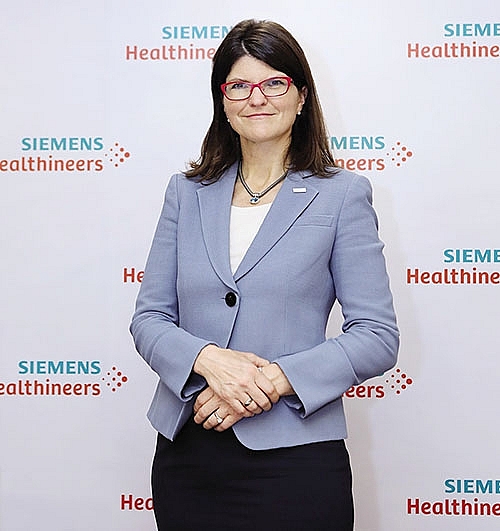Siemens Healthineers’ AI solutions for better healthcare
 |
| Elisabeth Staudinger, president of Siemens Healthineers in the Asia-Pacific |
The Fourth Industrial Revolution is exerting great influence on every sector. How is this trend shaping healthcare, and what does Vietnam need to do to keep up with digitalisation in healthcare?
Digital transformation is making great impacts on the healthcare sector. In many ways, Vietnam is doing a very good job, if you look at the money the country spends, GDP growth, and the health outcome that it creates for the population. Vietnam is getting a very quick return on investment.
The key to improving healthcare quality and patient outcomes is standardising processes and procedures. The second area that I think is very important for Vietnam is to create the infrastructure for digitalisation. However, in order to realise the opportunities, hospitals need to invest in information systems and radiology laboratory information systems because only with the infrastructure can they build AI and digital solutions on top. I believe this is one core investment, creating a foundation for quality improvement
As a developing country, Vietnam has high demand but low access to better healthcare services at an affordable cost. Could Vietnam improve the situation with the support of digital technology, and how can Siemens Healthineers support Vietnam in this?
Digital technology is not all that expensive. The importance for Vietnam is to create a basic infrastructure network, having connectivity between one place and the next. Also, basic IT infrastructure in hospitals will be needed if you want to move the healthcare system to the next level.
I do believe this does not cost money or require investment. Vietnam is reachable. It is not something so expensive that only rich countries can afford. Good examples would be emerging countries like India and China where people are experimenting a lot with different IT solutions. And Vietnam, which has a strong IT industry, does not have to wait for someone to bring the solutions to it, it can create its own.
There are different ways for Siemens Healthineers to contribute. One way is to increase the skill level and the other is to provide affordable high-quality equipment. This is the less expensive path today. This is driven by innovation, by looking for ways to create the same quality of diagnosis at a much lower cost, making technology easier and more affordable for the healthcare system.
Vietnam is starting to leverage digitalisation in the healthcare sector and Siemens Healthineers can support this path. For example, Vietnam has remote areas in the northern region where it is not easy to get good medical care. Our syngo Virtual Cockpit software solution connects healthcare facilities in remote areas to radiologists in a central hub, offering expertise from afar. The ability to deploy experienced technologists across multiple locations healthcare providers virtually can transform care delivery and achieve a higher level of standardisation that leads to more accurate diagnoses. This kind of technology is the most promising approach. With the development of the healthcare sector in Vietnam, I do believe that the most likely method of co-operation is public private partnership.
We will continue to invest in training. We also have the capability to provide consultancy for hospital providers on optimising procedures. We are working on the creation of something we call value partnerships under which we not only provide equipment, but really look at optimising operations today, expanding new capabilities tomorrow, and advancing the level of innovation. We have plenty of suggestions for healthcare providers to improve and become more efficient, and improve the quality of care.
We use these value partnerships in our direct dealings with the Vietnamese government and in the large-scale project that we are working on with Hanoi.
What changes have Siemens Healthineers’ AI and machine learning technologies produced, and how can digitalisation optimise resources and keep total healthcare affordable?
Patients are becoming consumers. They are taking ownership of health. This is also an area where digitalisation is taking place today. If you do not feel well, you pick up the phone and start checking. This is where the patient experience is becoming even more important.
AI and machine learning in radiology is a good example of this. Today it is not unusual for radiology departments in countries like Vietnam to carry out hundreds of diagnoses a day. The more diagnoses you have to do a day, the higher the risk of a mistake. If you apply technology solutions like our AI, you can make radiology reports faster because it takes over routine work and allows radiologists to focus on what is important, thus helping increase productivity, reduce pressure on radiologists, and at the same time increase the accuracy of diagnosis.
What the stars mean:
★ Poor ★ ★ Promising ★★★ Good ★★★★ Very good ★★★★★ Exceptional
Related Contents
Latest News
More News
- Businesses ramp up production as year-end orders surge (December 30, 2025 | 10:05)
- Vietjet chairwoman awarded Labour Hero title (December 29, 2025 | 13:06)
- How to unlock ESG value through green innovation (December 29, 2025 | 10:03)
- AI reshapes media and advertising industry (December 29, 2025 | 08:33)
- FPT and GELEX sign deal to develop blockchain tech for global markets (December 29, 2025 | 08:29)
- Vietnam’s GDP forecast to grow by 9 per cent in 2026 (December 29, 2025 | 08:29)
- Women entrepreneurs are key to Vietnam’s economic growth (December 29, 2025 | 08:00)
- Vietnam's top 500 value-creating enterprises announced (December 27, 2025 | 08:00)
- The PAN Group shaping a better future with ESG strategy (December 26, 2025 | 09:00)
- Masan Consumer officially lists on HSX, marking the next phase of value creation (December 25, 2025 | 13:20)

 Tag:
Tag:




















 Mobile Version
Mobile Version